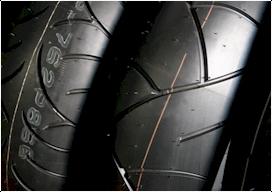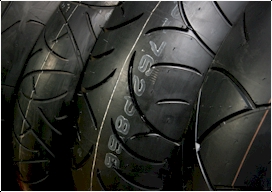

Tyres
All makes supplied, fitted and balanced.
 |
 |
Running Tyres In
It's important to understand that running tyres in doesn't just mean scrubbing-in the tyre surface. Scrubbing a tyre surface is only one of the reasons for running tyres in:
| • | A tyre needs to be seated on the wheel. This is not fully achieved when fitting the tyre and it needs to be ridden on with caution to complete the process. |
| • | In order to achieve optimum performance, the various components of the tyre (belts, tread strip, etc.) need to correctly bed-in to one another. If not correctly run-in, a tyre may not give the best possible performance. |
| • | When new, a tyre has a very smooth surface and in order to obtain optimum grip, the smooth surface needs to be scrubbed in. At first the bike should be ridden as upright as possible. Gradually, the angle of lean can be increased, always ensuring that a portion of scrubbed-in tread remains in contact with the road until full lean angles are achieved. During this time the bike should be ridden cautiously. Hard or sudden acceleration and braking should be avoided because optimum traction levels will not be achieved until the running process is completed. |
Not all manufacturers use releasing agents during the manufacturing process, but for those that do, the scrubbing-in process will need to take into account the fluid residue as well as the smooth surface. These agents can also contain anti-ageing preservatives and this is why the manufacturers do not remove them before shipping to their customers.
Wet weather can increase the required running-in distance by as much as three times.
Rubbing a new tyre's surface with an abrasive material in order to scrub the surface in, has little affect. Even very abrasive materials will not scrub the tyre's surface sufficiently for the bike to be ridden hard right away. And besides, the tyre still needs to be seated on the wheel and the various components still need to be bedded-in against one another. Put simply, there is no short cut to running a tyre correctly.
Following the fitting procedure, the tyre should be wiped with a dry cloth in order to ensure no residue of tyre fitting lubricant remains. 100 miles is considered a safe distance to run tyres in. When this distance has been covered, the tyre should be checked to ensure correct seating and inflation.
If a crash occurs on a new tyre, and assuming it has no fitting paste residue, it is very unlikely the tyre is at fault. Thankfully, very few people crash on new tyres, but in virtually every case we have been notified of it can be put down to lack of care by the rider. Over the years we have found that if a crash occurs it is often that it is more often than not after a new rear tyre has been fitted, usually within the first mile, invariably at low speed and generally when the rider is making one of the three following manoeuvres:
| • | Pulling out onto the road when leaving the fitting bay. |
| • | Turning right when pulling out of a T-junction. |
| • | On a low speed roundabout |
In these cases, riders have been leaning their bikes over far more than they realised and combined with an opening throttle, the new smooth tyre with its reduced traction levels can spin up with obvious results. These crashes usually happen at low speeds because the forces acting upon the tyre are lower than a higher speed and therefore it is far easier for a tyre to lose traction.
Mixing Tyres
We are often asked whether tyres from different manufacturers can be mixed on the same bike. The simple answer is: we don't know. It may be that a front tyre from Bridgestone happens to work fine on a GSX-R600 with a rear tyre from Pirelli, but this is no guarantee that the same combination will work on a CBR600RR. Neither is it a guarantee that a front tyre from Dunlop will work fine on the GSX-R600 with a rear tyre from Michelin. Manufacturers develop their tyres in matching pairs and that is the only way you will achieve optimum performance. No manufacturer test their tyres in combination with tyres from other manufacturers - why should they? They are in the business in selling their own tyres, not other manufacturer's. Much of the time it is not even possible to mix tyres from one manufacturer on the same bike, e.g. a Bridgestone BT-014 front with a Bridgestone BT-020NT rear. This is because individual types of tyre have different handling characteristic and fitting mixed pairs may result in high-speed instability or other dangerous handling problems.
Not all tyres suit all bikes
It is not safe to assume that all tyres will suit all bikes. Just because a tyre is available in a size to fit a bike, it doesn't automatically follow the the tyre is suitable for the bike. The most common example of this is the 190/50ZR17 BT-020, which was designed especially for the GSX1400. In order to obtain reasonable mileage, many people are fitting this sport touring tyre to R1s, GSX-R1000s, CBR900RRs, etc. What they are failing to take into account is whether a tyre designed specifically for a steady handling naked bike that weighs 230kg will even work on their 170kg, super-fast-steering full-on sports bike.
Tyre Clearance
Due to centrifugal forces and in-service temperature changes, a tyre's overall diameter will increase during use. It is also possible that there may be some lateral growth for the same reasons. Bias ply (crossply) and bias belted tyres will exhibit greater growth than radial tyres.
For this reason we advise that the following fitment you ensure there is 4mm lateral and 14mm radial clearance to any part of the motorcycle, e.g. mudguards, forks, swing-arm, hugger, etc. Bear in mind that some clearances can change with suspension movement.
Dynamometer Testing
Dyno testing places extremely high loads in concentrated areas on motorcycle tyres. It is possible that damage which may be invisible to the naked eye can occur to the tyre's construction during dyno runs. It is also possible that this damage may result in tyre failure later. Tyres that have been used for dyno testing should not then be used on road or track. Dyno tests should only be carried out on worn out tyresm which can then be discarded.
Puncture Repairs
Avon, Bridgestone, Continental, Dunlop, Metzeler and Pirelli all approve repairs to their motorcycle tyre in accordance with British Standard BS AU159/f, which states:
| • | Up to and including J speed rating (62mph) 2 repairs per tyre, not exceeding 6mm in diameter |
| • | Above J speed rating and up to V speed rating (149mph) 1 repair per tyre, not exceeding 3mm diameter. |
The above repairs must be restricted to the centre tread are, 25% of the nominal section width either side of the tyre's centre line. Repairs must only be made using mushroom-type plug.
Mitchelin is the only manufacturer that approves repairs to it Wand Z speed rated tyres. All Mitchelin tyres are permitted to have 2 repairs per tyre with a maximum diameter of 6mm.